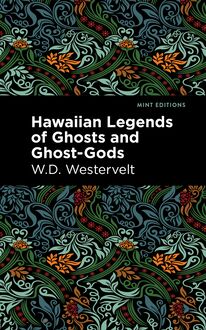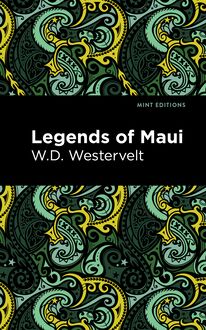-
 Univers
Univers
-
 Ebooks
Ebooks
-
 Livres audio
Livres audio
-
 Presse
Presse
-
 Podcasts
Podcasts
-
 BD
BD
-
 Documents
Documents
-
- Cours
- Révisions
- Ressources pédagogiques
- Sciences de l’éducation
- Manuels scolaires
- Langues
- Travaux de classe
- Annales de BEP
- Etudes supérieures
- Maternelle et primaire
- Fiches de lecture
- Orientation scolaire
- Méthodologie
- Corrigés de devoir
- Annales d’examens et concours
- Annales du bac
- Annales du brevet
- Rapports de stage
La lecture à portée de main
Vous pourrez modifier la taille du texte de cet ouvrage
Découvre YouScribe en t'inscrivant gratuitement
Je m'inscrisDécouvre YouScribe en t'inscrivant gratuitement
Je m'inscrisEn savoir plus
Vous pourrez modifier la taille du texte de cet ouvrage
En savoir plus

Description
A moving account of Hawaii’s most culturally significant stories, presented by King David Kalākaua.
The Legends and Myths of Hawaii introduces readers to the social, historical, and religious customs of native Hawaiians, revealing the history of a culture that, for many years, functioned without outside influence. Chapters on leaders such as “Hina, the Helen of Hawaii,” “Hua, King of Hana,” and “Kelea, the Surf-Rider of Maui” illustrate Hawaii’s most important tales and traditions. Originally published in 1888, King David Kalākaua’s book remains a compelling and enduring collection of the archipelago's most memorable tales.
With an eye-catching new cover and professionally typeset manuscript, this edition of The Legends and Myths of Hawaii is specially designed for modern readers. Add this beautiful edition to your bookshelf, or enjoy the digital edition on any e-book device.
Sujets
Informations
| Publié par | Mint Editions |
| Date de parution | 02 mars 2021 |
| Nombre de lectures | 1 |
| EAN13 | 9781513278001 |
| Langue | English |
| Poids de l'ouvrage | 4 Mo |
Informations légales : prix de location à la page 0,0500€. Cette information est donnée uniquement à titre indicatif conformément à la législation en vigueur.
Extrait
The Legends and Myths of Hawaii
David Kalākaua
The Legends and Myths of Hawaii was first published in 1888.
This edition published by Mint Editions 2021.
ISBN 9781513277592 | E-ISBN 9781513278001
Published by Mint Editions®
minteditionbooks.com
Publishing Director: Jennifer Newens
Design & Production: Rachel Lopez Metzger
Project Manager: Micaela Clark
Typesetting: Westchester Publishing Services
C ONTENTS H AWAIIAN L EGENDS : I NTRODUCTION H INA , THE H ELEN OF H AWAII T HE R OYAL H UNCHBACK T HE T RIPLE M ARRIAGE OF L AA - MAI - KAHIKI T HE A POTHEOSIS OF P ELE H UA , K ING OF H ANA T HE I RON K NIFE T HE S ACRED S PEAR -P OINT K ELEA , THE S URF -R IDER OF M AUI U MI , THE P EASANT P RINCE OF H AWAII L ONO AND K AIKILANI T HE A DVENTURES OF I WIKAUIKAUA T HE P ROPHECIES OF K EAULUMOKU T HE C ANNIBALS OF H ALEMANU K AIANA , THE L AST OF THE H AWAIIAN K NIGHTS K AALA , THE F LOWER OF L ANAI T HE D ESTRUCTION OF THE T EMPLES T HE T OMB OF P UUPEHE T HE S TORY OF L AIEIKAWAI L OHIAU , THE L OVER OF A G ODDESS K AHAVARI , C HIEF OF P UNA K AHALAOPUNA , THE P RINCESS OF M ANOA A PPENDIX
H AWAIIAN L EGENDS : I NTRODUCTION
P HYSICAL C HARACTERISTICS OF THE H AWAIIAN I SLANDS — H ISTORIC O UTLINES —T HE T ABU —A NCIENT R ELIGION — A NCIENT G OVERNMENT —A NCIENT A RTS , H ABITS AND C USTOMS —T HE H AWAII OF T O - DAY .
General Retrospect
T HE LEGENDS FOLLOWING ARE OF a group of sunny islands lying almost midway between Asia and America—a cluster of volcanic craters and coral-reefs, where the mountains are mantled in perpetual green and look down upon valleys of eternal spring; where for two-thirds of the year the trade-winds, sweeping down from the northwest coast of America and softened in their passage southward, dally with the stately cocoas and spreading palms, and mingle their cooling breath with the ever-living fragrance of fruit and blossom. Deeply embosomed in the silent wastes of the broad Pacific, with no habitable land nearer than two thousand miles, these islands greet the eye of the approaching mariner like a shadowy paradise, suddenly lifted from the blue depths by the malicious spirits of the world of waters, either to lure him to his destruction or disappear as he drops his anchor by the enchanted shore.
The legends are of a little archipelago which was unknown to the civilized world until the closing years of the last century, and of a people who for many centuries exchanged no word or product with the rest of mankind; who had lost all knowledge, save the little retained by the dreamiest of legends, of the great world beyond their island home; whose origin may be traced to the ancient Cushites of Arabia, and whose legends repeat the story of the Jewish genesis; who developed and passed through an age of chivalry somewhat more barbarous, perhaps, but scarcely less affluent in deeds of enterprise and valor than that which characterized the contemporaneous races of the continental world; whose chiefs and priests claimed kinship with the gods, and step by step told back their lineage not only to him who rode the floods, but to the sinning pair whose re-entrance to the forfeited joys of Paradise was prevented by the large, white bird of Kane; who fought without shields and went to their death without fear; whose implements of war and industry were of wood, stone and bone, yet who erected great temples to their gods, and constructed barges and canoes which they navigated by the stars; who peopled the elements with spirits, reverenced the priesthood, bowed to the revelations of their prophets, and submitted without complaint to the oppressions of the tabu; who observed the rite of circumcision, built places of refuge after the manner of the ancient Israelites, and held sacred the religious legends of the priests and chronological meles of the chiefs.
As the mind reverts to the past of the Hawaiian group, and dwells for a moment upon the shadowy history of its people, mighty forms rise and disappear—men of the stature of eight or nine feet, crowned with helmets of feathers and bearing spears thirty feet in length. Such men were Kiha, and Liloa, and Umi, and Lono, all kings of Hawaii during the fifteenth and sixteenth centuries; and little less in bulk and none the less in valor was the great Kamehameha, who conquered and consolidated the several islands under one government, and died as late as 1819. And beside Umi, whose life was a romance, stands his humble friend Maukaleoleo, who, with his feet upon the ground, could reach the cocoanuts of standing trees; and back of him in the past is seen Kana, the son of Hina, whose height was measured by paces.
And, glancing still farther backward through the centuries, we behold adventurous chiefs, in barges and double canoes a hundred feet in length, making the journey between the Hawaiian and more southern groups, guided only by the sun and stars. Later we see battles, with dusky thousands in line. The warriors are naked to the loins, and are armed with spears, slings, clubs, battle-axes, javelins and knives of wood or ivory. They have neither bows nor shields. They either catch with their hands or ward with their own the weapons that are thrown. Their chiefs, towering above them in stature, have thrown off their gaudy feather cloaks and helmets, and, with spear and stone halberd, are at the front of battle. The opposing forces are so disposed as to present a right and left wing and centre, the king or principal chief commanding the latter in person. In the rear of each hostile line are a large number of women with calabashes of food and water with which to refresh their battling fathers, husbands and brothers. While the battle rages their wails, cries and prayers are incessant, and when defeat menaces their friends they here and there take part in the combat. The augurs have been consulted, sacrifices and promises to the gods have been made, and, as the warring lines approach, the war-gods of the opposing chiefs, newly decorated and attended by long-haired priests, are borne to the front. War-cries and shouts of defiance follow. The priests retire, and the slingers open the battle. Spears are thrown, and soon the struggle is hand-to-hand all over the field. They fight in groups and squads around their chiefs and leaders, who range the field in search of enemies worthy of their weapons. No quarter is given or expected. The first prisoners taken are reserved as offerings to the gods, and are regarded as the most precious of sacrifices. Finally the leading chief of one of the opposing armies falls. A desperate struggle over his body ensues, and his dispirited followers begin to give ground and are soon in retreat. Some escape to a stronghold in the neighboring mountains, and a few, perhaps, to a temple of refuge; but the most of them are overtaken and slain. The prisoners who are spared become the slaves of their captors, and the victory is celebrated with feasting and bountiful sacrifices to the gods.
This is a representative battle of the past, either for the supremacy of rival chiefs or in repelling invasion from a neighboring island. But here and there we catch glimpses of actual conflicts indicative of the warlike spirit and chivalry of the early Hawaiians. Far back in the past we see the beautiful Hina abducted from her Hawaiian husband by a prince of Molokai, and kept a prisoner in the fortress of Haupu until her sons grow to manhood, when she is rescued at the end of an assault which leaves the last of her defenders dead. Later we see the eight hundred helmeted chiefs of the king of Hawaii, all of noble blood, hurling themselves to destruction against the spears of the armies of Maui on the plains of Wailuku. And then, less than a generation after, Kamehameha is seen in the last battle of the conquest, when, at the head of sixteen thousand warriors, he sweeps the Oahuan army over the precipice of Nuuanu and becomes the master of the archipelago. Finally we behold Kekuaokalani, the last defender in arms of the Hawaiian gods and temples, trampling upon the edict of the king against the worship of his fathers, and dying, with his faithful wife Manono, on the field of Kuamoo.
In the midst of these scenes of blood the eye rests with relief upon numerous episodes of love, friendship and self-sacrifice touching with a softening color the ruddy canvas of the past. We see Kanipahu, the exiled king of Hawaii, delving like a common laborer on a neighboring island, and refusing to accept anew the sceptre in his old age because his back had become crooked with toil and he could no longer look over the heads of his subjects as became a Hawaiian king. We see Umi, a rustic youth of royal mien and mighty proportions, boldly leap the palace-walls of the great Liloa, push aside the spears of the guards, enter the royal mansion, seat himself in the lap of the king, and through the exhibition of a forgotten token of love receive instant recognition as his son. And now Lono, the royal great-grandson of Umi, rises before us, and we see him lured from self-exile by the voice of his queen, reaching him in secret from without the walls of the sovereign court of Oahu, to return to Hawaii and triumph over his enemies. These and many other romantic incidents present themselves in connection with the early Hawaiian kings and princes, and are offered in the succeeding pages with every detail of interest afforded by available tradition.
Physical Characteristics
A FEW GENERAL REMARKS CONCERNING the physical characteristics of the Hawaiian Islands would seem to be appropriate in presenting a collection of legends dealing alike with the history and folk-lore of their people. The islands occupy a place in a great waste of the Pacific between the nineteenth and twenty-third degrees of north latitude, and the one hundred
-
 Univers
Univers
-
 Ebooks
Ebooks
-
 Livres audio
Livres audio
-
 Presse
Presse
-
 Podcasts
Podcasts
-
 BD
BD
-
 Documents
Documents
-
Jeunesse
-
Littérature
-
Ressources professionnelles
-
Santé et bien-être
-
Savoirs
-
Education
-
Loisirs et hobbies
-
Art, musique et cinéma
-
Actualité et débat de société
-
Jeunesse
-
Littérature
-
Ressources professionnelles
-
Santé et bien-être
-
Savoirs
-
Education
-
Loisirs et hobbies
-
Art, musique et cinéma
-
Actualité et débat de société
-
Actualités
-
Lifestyle
-
Presse jeunesse
-
Presse professionnelle
-
Pratique
-
Presse sportive
-
Presse internationale
-
Culture & Médias
-
Action et Aventures
-
Science-fiction et Fantasy
-
Société
-
Jeunesse
-
Littérature
-
Ressources professionnelles
-
Santé et bien-être
-
Savoirs
-
Education
-
Loisirs et hobbies
-
Art, musique et cinéma
-
Actualité et débat de société
- Cours
- Révisions
- Ressources pédagogiques
- Sciences de l’éducation
- Manuels scolaires
- Langues
- Travaux de classe
- Annales de BEP
- Etudes supérieures
- Maternelle et primaire
- Fiches de lecture
- Orientation scolaire
- Méthodologie
- Corrigés de devoir
- Annales d’examens et concours
- Annales du bac
- Annales du brevet
- Rapports de stage















